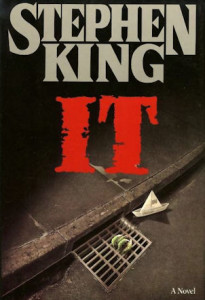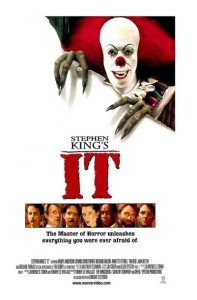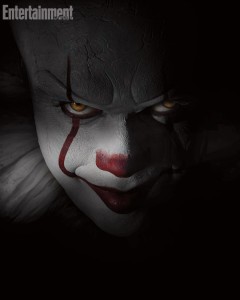Warning: The following contains spoilers for Stephen King’s original novel IT, the 1990 television miniseries, and the upcoming 2017 theatrical release.
The Urban Legend
Just like the kids in Stephen King’s seminal 1986 novel IT, my first encounter with Pennywise the Dancing Clown was in the fifth grade. I hadn’t yet been exposed to Stephen King’s book or Tim Curry’s brilliant performance in the small screen adaptation, but I knew the legend. A childhood classmate of mine regaled my friends and I with the tale of a young boy who just wanted to sail his paper boat on the flooded streets of his neighborhood. Of the murderous clown that took his life and the friends that united to fight back.
But the tale we were told didn’t take place in the fictional town of Derry, Maine. Instead, it took place in our neighborhood. The boy with the paper boat went to our school years before, as did the kids that finally put a stop to the rampage of Pennywise. For us, the story became the stuff of urban legend.
A few years later, I was at home with the babysitter when I saw the legend come to life. A little boy sailed a boat to his grisly end on the television as I watched in terror. I already knew how this story would end. It was hard to believe what I was seeing. For a moment, I thought that maybe I was going crazy, but the sitter seemed to see what I was seeing as well.
Watching the miniseries that night had a profound effect on me. In some ways it was a release of the fears I had of the local boogeyman. I realized that my town may be safe from the grasp of the killer clown after all. In another way, it personified that fear in the form of Tim Curry. To this day, that performance has made it impossible for me to put my foot anywhere near the shower drain.
That same year I was handed the novel that served as the basis for both the urban legend and the miniseries. It was a first edition copy, well loved, but intriguing nonetheless. By now I had discovered that my classmate’s sister had read the very book I now held in my hands, which of course lead to our eventual urban legend.
I tried reading the book to no avail. It seemed no matter how often I attempted to pick it up, I just wasn’t ready. And so the book, much like the story of Pennywise himself, passed into legend (a box in my closet). But the book followed me.
I forgot about its existence for a long time, but it always managed to survive the many changes in my life. It persevered through basement floods, spring cleanings, garage sales, and even a move across the country and back again. Like the adults who returned to their hometown to do battle with their childhood nemesis, my memory of owning the book had all but disappeared.
Just last month, it all came flooding back. My books have been languishing in a box in the basement of my new place, and amidst a barrage of movies, I decided it was time to get back into reading. I dug out a stack of books, with no real plan as to what I would read. When I saw my copy of IT, given to me so many years before; all of my Pennywise-related memories returned.
I knew right away that this time I was ready. Nearly twenty years after that first encounter with my very own urban legend, I was finally ready to take on all 1,100 plus pages. My foray into the heart of Derry turned out to be one of the most uniquely rewarding experiences I’ve ever had as a lover of the written word, and of cinema.
The Book and the Miniseries
The experience of reading IT opened my eyes to the process of adapting a written work for television and film. As an avid movie-goer, I’ve heard the classic “the book was better” line countless times. And more often than not, that thought proves true. The pitfalls of an adaptation usually fall into one of two camps: being too slavish to the source material or losing the essence of the story amongst a multitude of changes.
Having watched the miniseries many times before ever conquering the novel, I found myself understanding the alterations, the new additions, and even the missing pieces of that series. I’ve been spurned by adaptations before (The Lord of the Flies) and seen them stand perfectly alongside/improve upon the source material (Jurassic Park). But with IT, the series had always been MY version of the story.
Reading the book, I felt as if I had an inside look into the thought process of the creative minds behind the TV adaptation. Quite frankly, there were characters, scenes, and themes that simply could not translate to the screen. Even in the extended multi-night format of the series, there is no way to adequately adapt the entirety of the story, especially in the case of the more metaphysical elements present in the original text.
It became easy to see the writers sitting down to decide where the various chess pieces needed to be moved. Scenes involving the deeper origins of Pennywise itself had to be excised (a giant space turtle is awfully hard to explain), as did scenes involving sexuality among the young characters. But more interestingly than the scenes that were cut, I found myself understanding the re-arranging of events, characters, and timelines.
The miniseries was by no means perfect, but it managed to take a huge book (big enough to knock somebody out with it) create a screen version with a lasting impact on me and many others who grew up watching Tim Curry terrorize small children. 
After consuming the book and re-watching the series, I’ve found an appreciation for both. With the upcoming theatrical release of a two-part IT adaptation, I find myself looking at what each version of the tale did right, and what this iteration can do to make the tale of Pennywise and the Losers Club the definitive horror story for a new generation.
27 years after Tim Curry donned the clown makeup (creepily falling in line with the same time span cycle as Pennywise’s murders). Director Andy Muschietti (Mama) has commenced shooting in Ontario. The young cast includes Bill Skaarsgard (Hemlock Grove) as the titular antagonist. This film has the potential to be the perfect screen adaptation of King’s novel. The creative team needs to include scenes and characters that were excised from the first adaptation while making the cuts necessary for the visual medium of film.
What Needs To Go
- Sexual Situations
There are a couple of key scenes from the novel involving the adolescent characters dealing with sex. The first instance revolves around an encounter between two of the bullies that torment the young heroes. The other involves the Losers Club engaging in a sexual act to mystically find their way out of the sewers below Derry.
Both of these scenes are incredibly uncomfortable to read, and would be unbearable to watch. With the minor exception of adding an extra layer to Henry Bowers’ anger, these scenes really don’t do anything to add to the narrative as a whole.
- The Death of Eddie Corcoran
The aforementioned death of Patrick Hockstetter, as well as that of Adrian Mellon; both serve as stark reminders of just how vicious Pennywise is as a villain. These two deaths both hit hard in their own ways, and make Eddie Corcoran’s death relatively pointless from a plot standpoint.
Eddie Corcoran’s chapter in the novel is great, but it makes the character come with a lot of narrative baggage. For his death to have a legitimate lasting impact on us, we need to know about his home life, the tragedy of his brother’s death, and his motivations for running away. There are far more important subplots than this, and rather than including an abridged version, it should be cut entirely.
- Tom Rogan’s Road Trip
The film needs to include Tom as a foil for Beverley. He’s a crucial characters when it comes to showing us how she has never truly escaped the clutches of her father, but Tom’s role should remain limited to being a complete and utter bastard, then getting his ass kicked for it.
His journey to Derry to hunt down his estranged wife only leads to Audra being kidnapped and taken hostage by Pennywise. After that, he falls down dead in the wake of witnessing the “dead lights” head on. There are plenty of other ways to show the powers of suggestion and mental manipulation that Pennywise often employs.
- The Adultery Subplot
Bill and Beverley’s one night stand makes for some dramatic tension in the novel. It also gives Bill feelings of doubt about his ability to defeat Pennywise. His guilt over cheating on Audra becomes another hurdle for Bill to overcome.
That being said, it also makes Bill look like kind of a dick, as well as undermining the budding relationship between Ben and Beverley. Ultimately, it simply doesn’t add enough to the final conflict, and could even damage the audiences opinions of Bill as the hero of the story.
- The Turtle
The “Turtle” and the “Other” are two beings of the “Macroverse” that imbue the Losers Club with the powers to defeat Pennywise. While I am absolutely behind the idea of an unseen/unexplained force helping to push the gang along in their quest, the inclusion of these characters will only serve to confuse audiences.
Without the benefit of the novel’s length and the subsequent ties into Stephen King’s Dark Tower saga, these beings will only serve to confuse and bewilder audiences .
- The Ritual of Chud
Used as the method of defeating Pennywise, the “Ritual of Chud” involves a battle taking place at the far end of the “Macroverse” including the “Turtle” and a bevy of otherworldly imagery. A filmed version of the story requires a more physical, real-world confrontation with Pennywise.
What Needs To Stay
- The Death of Patrick Hockstetter
Patrick’s death in the novel may be the most brutal in terms of sheer gruesomeness. Given the character’s backstory and legitimately psychotic tendencies, it was almost hard not to root for Pennywise. It’s a hauntingly memorable moment in the book that can finally be realized in an R-rated film.
There really won’t be any room in an already loaded film for a section dedicated to Patrick (and a lot of what he does is way too brutal for a theatrical audience). There are however plenty of opportunities during the Bowers gang’s many attacks on the Losers for Patrick’s psychosis to come through.
- The House on Neibold Street
Eddie Kasbrack’s first visit to this house of horrors and his first encounter with “the Leper” make it one of the most indelible locations in the novel. Bill and Richie’s return to the house also makes for one of the most tension-filled sequences in the story. These should both leave a mark on theatergoers.
The final visit to Neibolt Street with the entire Losers Club in tow features some of the biggest scares and action sequences throughout the 1958 sections of the story. All three of these trips to the house were sadly excised from the miniseries, and NEED to be included this time around.
- The Arrival of It
There are plenty of metaphysically heavy scenes to leave on the cutting room floor, but the coming of Pennywise to the place that will eventually become Derry is an incredible scene. Whether the kids see this moment through their visions in the smoke hole, or they simply have shared dreams of the event, there’s something mysterious and terrifying about the entire scene.
- The Children’s Fears
Many of Pennywise’s more memorable guises weren’t present in the miniseries. The giant bird, the dead children of Derry, the Paul Bunyan statue, and the shark from Jaws are all transformations I’d love to see on the big screen. Given the new film’s shift in timeline (1989 instead of 1958) some of these creatures could use updating to reflect the childhood fears of that decade. Instead of the Creature from the Black Lagoon, picture a hulking, machete wielding, masked killer instead.
Perhaps the most well-remembered (and often disliked) form that Pennywise takes is that of a giant spider. This is the final form that the kids (and their adult counterparts) do battle with and destroy at the end of the novel/miniseries.
Quite frankly, I think the new film should do away with this climax. Any savvy movie-goer has seen more than their fair share of giant spiders on screen, which diminishes the overall effect. It also diminishes Pennywise, especially when he’s replaced by a (presumably) CGI spider for the film’s final confrontation. I would personally love to see the kids take on an ever-shifting Pennywise, constantly changing his shape as he attacks them (imagine the nasty looking combinations he could come up with).
- Pennywise’s Mean Streak
Like many of the kids who were exposed to IT through the 90s miniseries, I love Tim Curry’s performance. He’s creepy, funny, and sometimes downright bizarre as Pennywise. Unfortunately, the limitations of network television kept him from really cutting loose and fully taking on the nasty, vile, and perverse actions of Pennywise. I’d like to see more of this attitude in the new film.
I’m looking forward to the corruption of Derry as well. This is an aspect lightly touched upon in the miniseries, but has so much potential and room for expansion. Pennywise’s nastiness poisons the town of Derry to the point that the two become psychically connected. When he is finally defeated, the town crumbles, leading to a much more impactful ending in the novel. I am really hoping that this makes the cut.
The Cycle Continues…
Next year we will hear the tale of IT once again, and I for one cannot wait to see how it all unfolds. My only hope is that Andy Muschietti and crew are able to capture the spirit of the novel, while making the appropriate alterations to both expand the scope of the story, while keeping it grounded enough to serve as a portrait of childhood’s end.
2017’s IT could manage to become much the same urban legend that it transformed into for me and my friends. The film could serve a similar function as the mini-series in providing an entry into the wider world of horror for kids who find more than just fear in tales of the unknown. I truly hope that the movie can help to inspire a new generation of young horror fans looking for something relatable to the challenges they face in their young lives.
The potential for this film (and its subsequent follow-up) is huge, and regardless of the creative decisions made, I certainly hope the filmmakers manage to walk the fine line between faithful adaptation and original vision of horror.

Leave a Reply
You must be logged in to post a comment.